The Three Dolls Chapter Notes | English Class 3 ICSE PDF Download
| Table of contents |

|
| Introduction |

|
| Key Points |

|
| Explanation |

|
| Message |

|
Introduction
The chapter "The Three Dolls" is an interesting story about Tenali Raman, a smart poet who worked for King Krishnadevaraya of Vijayanagar. He was famous for his quick thinking and clever ideas. The story begins when a merchant from a faraway place visits the king’s court with a challenge involving three dolls that look the same. Tenali uses his wisdom to solve the puzzle, proving his intelligence and teaching a meaningful lesson. This tale is full of excitement and shows how smart thinking can help in tough situations.
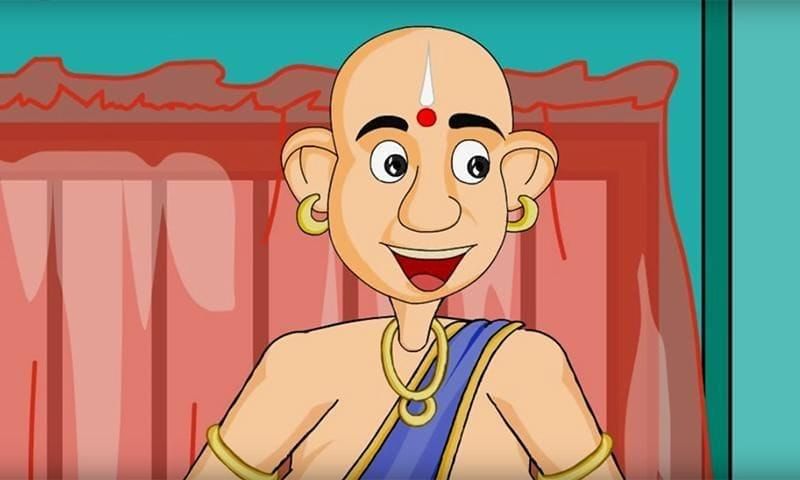
Key Points
The story is about:
- Tenali Raman was a talented poet and the king’s favorite courtier known for his wit.
- A merchant from a distant land brought three dolls that looked identical.
- The merchant challenged the king’s ministers to find the differences in the dolls.
- The king gave his ministers five days to solve the challenge.
- The ministers tried hard but could not find any differences and called Tenali for help.
- Tenali asked for three days and found the unique feature of each doll.
- He showed the differences by pouring water into the dolls’ ears.
- The merchant was impressed and praised the court’s wisdom.
Explanation
Scene 1: The Merchant’s Challenge and the Court’s Struggle
The story begins in the grand court of King Krishnadevaraya in Vijayanagar, where the king is talking with his helpers. A soldier enters and tells the king that a merchant from a faraway land wants to meet him. The king agrees, and a man in fancy clothes walks in with a big box. He bows to the king and says he has heard about the court’s wise helpers and wants to test their intelligence. The king, proud of his team, agrees.
The merchant opens his box and shows three dolls that look exactly the same, with identical eyes, nose, ears, hair, and clothes. He asks the king if he can see any differences, but the king looks closely and says they all look alike. The merchant says the dolls are different and challenges the king’s helpers to find out how. He says if they figure it out, he’ll believe they are truly wise, but if they fail, he’ll think the stories about their cleverness are just rumors. He promises to come back in seven days for the answer.
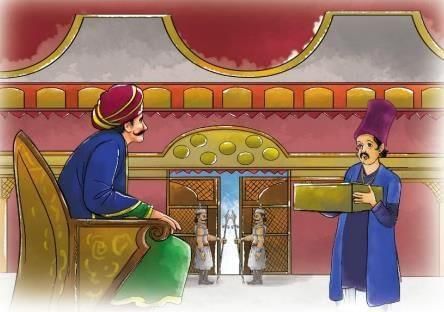
The king accepts the challenge and tells his helpers to solve it in five days. The helpers and wise scholars examine the dolls carefully, turning them around and checking every part, but they can’t find any differences. On the fifth day, they meet in the court, feeling worried. The First Helper says he checked every angle and found nothing different.
The Second Helper says all the features, like the faces and clothes, are the same. The Third Helper agrees that every detail matches perfectly. Feeling stuck, the Second Helper suggests asking Tenali Raman, who is known for solving hard problems. The king calls for Tenali, who arrives and bows. The king explains the challenge and asks Tenali to find the differences. Tenali looks at the dolls and asks for three days to think.
Scene 2: Tenali Solves the Puzzle and Explains the Lesson
Tenali spends three days studying the dolls carefully. On the seventh day, the merchant returns to the court, and everyone is waiting excitedly to see what will happen. The court is full of people talking about the challenge. The merchant asks the king for the answer, and the king looks at Tenali. Tenali steps forward with the three dolls and says they are different. He shows everyone by pouring water into each doll’s ear.
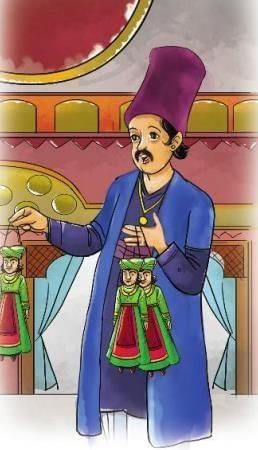
In the first doll, water goes in one ear and comes out of the mouth. In the second doll, water goes in one ear and comes out of the other ear. In the third doll, the water goes in and stays inside. The king is surprised and asks what this means. Tenali explains that the first doll is like people who learn something and share it with others to help them.
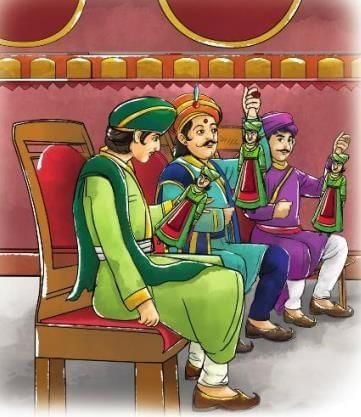 The second doll is like people who hear things but don’t care or understand. The third doll is like people who learn but keep their knowledge to themselves and don’t share it. The merchant agrees that Tenali is right and says this is the only difference between the dolls. He praises Tenali’s cleverness and says the king’s court is truly wise.
The second doll is like people who hear things but don’t care or understand. The third doll is like people who learn but keep their knowledge to themselves and don’t share it. The merchant agrees that Tenali is right and says this is the only difference between the dolls. He praises Tenali’s cleverness and says the king’s court is truly wise.
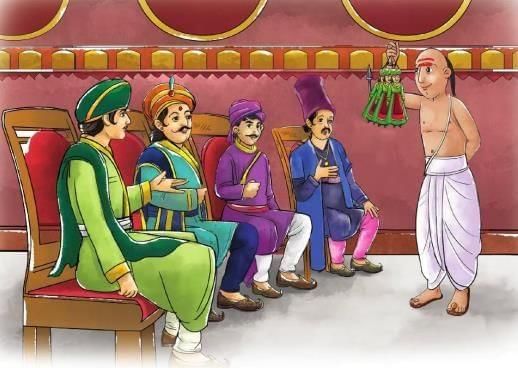
The king is very proud of Tenali and asks the merchant if he still doubts their intelligence. The merchant, happy with the answer, says no and calls the court’s helpers “true gems,” meaning they are very talented people. The story ends with everyone pleased that Tenali solved the puzzle and proved the court’s wisdom.
Message
The story teaches us that knowledge is valuable when shared with others. It shows that spreading what we learn helps everyone grow, while ignoring or hiding it is not useful. Tenali’s clever solution encourages us to think deeply and work together to overcome challenges.
New Words with Meanings
- Courtier: A person who works in the court of a king or queen.
- Merchant: Someone who buys and sells goods, especially between countries.
- Distant: Far away.
- Howsoever: By whatever way.
- Identical: Exactly the same.
- Puzzled: Confused.
- Conclude: To decide.
- Rumour: False information.
- Summons: Calls.
- Learned: Having a lot of knowledge.
- Honour: Good name and respect.
- Gaze expectantly: Look on hoping for something to happen.
- Demonstrate: Show clearly with proof.
- Take heed of: Pay attention to.
- Gems: (here) Gifted people.
|
36 docs|18 tests
|
FAQs on The Three Dolls Chapter Notes - English Class 3 ICSE
| 1. What is the main theme of "The Three Dolls"? |  |
| 2. Who are the main characters in "The Three Dolls"? |  |
| 3. What lesson can children learn from "The Three Dolls"? |  |
| 4. How does the story of "The Three Dolls" relate to real-life situations? |  |
| 5. What narrative techniques are used in "The Three Dolls"? |  |














